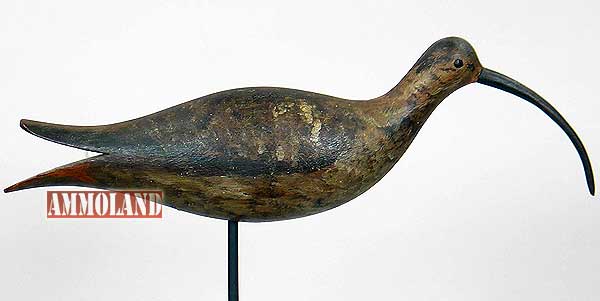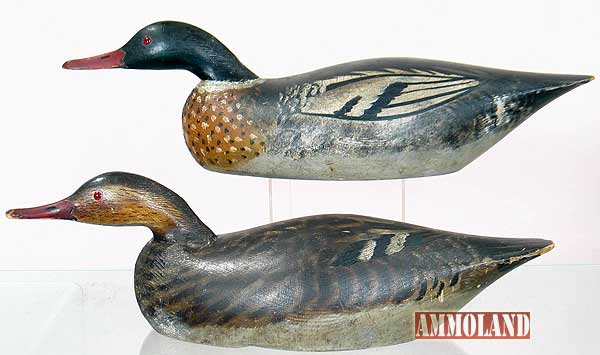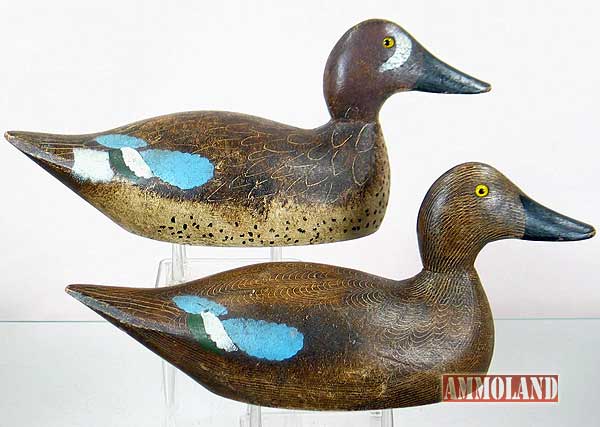Spectacular & Rare Sicklebill Curlew Decoy Soars To $111,550 At Auction
At The Auction Held July 24Th-25Th By Decoys Unlimited, Nearly 1,000 Lots Crossed The Block In A Successful Auction That Grossed More Than $1.2 Million.


HYANNIS, Mass. –-(Ammoland.com)- A spectacular and rare sicklebill curlew decoy made in Duxbury, Mass., by a craftsman whose identity is a matter of debate among veteran collectors, soared to $111,550 at an auction held July 24-25 by Decoys Unlimited, Inc., based in Barnstable, Mass. The sale was conducted at the Cape Codder Resort & Hotel in Hyannis, Mass., on Cape Cod.
The sicklebill curlew was described by Dr. George Ross Starr, in his book Decoys of the Atlantic Flyway, as “the finest example of a sicklebill decoy in my collection” and “the kind of a decoy a collector dreams about.” He called it “a beautifully proportioned piece of work.” It’s rare in part because sicklebill curlews are scarce in New England and therefore so are their decoys.
It was by far the top lot in an auction that saw just under 1,000 decoys change hands. About 400 people attended in person (121 were registered bidders), plus there were 57 absentee bidders and 90 phone bidders (who together bid on 639 lots). Internet bidding (via Artfact.com) had 153 registered bidders. All of these numbers were new records for Decoys Unlimited, Inc.
“The sale went well above our expectations despite a global economy that is still a bit anemic,” said Ted Harmon of Decoys Unlimited, Inc. “But the market for quality decoys is strong and I see it remaining that way for some time. The less expensive decoys were a bit off, but not as far off as they were last year.” The auction, he added, grossed more than $1.2 million.
Headlining the sale was the private collection of the late Joseph Bard “Joe” French, plus other quality consignments from across North America. Mr. French (1919-2009) was a pioneer in the hobby who collected his first decoy in 1954 and took delivery of his last decoy just two days before his passing. He also wrote extensively on the subject and produced decoy videos.
Following are additional highlights from the sale. All prices quoted include a 15 percent buyer’s premium.
The auction’s second top lot, at $60,375, was an outstanding hissing goose made circa early 1900s by George Boyd, the master decoy maker from Seabrook, N.H. The canvas over frame Canada goose boasted excellent, finely crackled original paint throughout plus a strong, nearly perfect wing, tail and cheek outline, and great feather detailing on the sides and rear neck.
Two lots posted identical sale prices of $37,375. One was an exceptionally rare pair of circa early 1900s unrigged and unused mergansers, acquired as a gift from Irving Wallace from Small Point, Maine. A letter of provenance came with the birds. The other was a pair of racy swimming red-breasted mergansers (circa 1918-1922) by A.E. Crowell of East Harwich, Mass.
A one-of-a-kind American merganser hen made in the late 1800s by the Stevens Factory of Weedsport, N.Y. (with the maker probably George Stevens, owing to the concave carving on the neck seat) went to a determined bidder for $29,900; and a pair of redheads crafted circa 1920s by the Ward Brothers of Crisfield, Md., with original paint on body and bill, hit $24,180.
Artwork was also featured in the auction. A framed oil on board of two mermaids and King Neptune by the noted Cape Cod artist Ralph Cahoon (1910-1982), a relative of C.D. Cahoon, who is said to have painted decoys for Elmer Crowell when he was behind on orders, brought $24,150. A second Ralph Cahoon work, depicting mermaids at auction, made $23,000.
A rare and early example of a sanderling (or “wind bird”), executed circa 1860-1890 and attributed to a member of the Chipman family of Sandwich (on Cape Cod), commanded $23,000; while a circa 1900 greater yellowlegs by A.E. Crowell featuring fine early period brushed soft original paint with very light wear and only a few very small scuffs knocked down at $18,400.
A pair of outstanding lots each fetched $17,200. The first was a circa-1909 eider drake by Augustus Aaron “Gus” Wilson, Maine’s most celebrated decoy maker. Wilson carved animated decoys of all types, including this early sculpture, in a career that spanned about five decades. The second was an early mallard drake by A.E. Crowell (circa 1915-1918) with original paint.
Another early example by A.E. Crowell – this one a circa-1915 golden plover with the original paint and in all-original condition with no repairs — crossed the block at $16,100; and a pair of Evans Factory (active 1921-1937) blue-winged teal (circa early 1900s), with early paint and the rare double blue speculum, plus the ‘Evans Decoy’ stamp on the bottom, rose to $14,950.
Rounding out the day’s top lots, a rare and oversize red-breasted merganser drake by Doug Jester of Chincoteaque, Va., having the original paint with some crazing, breezed to $13,800; and an early gunning model of an immature (or winter plumage) black-bellied plover by A.E. Crowell (circa 1905-1910), with extremely fine original paint, also gaveled for $13,800.
Ted Harmon has been in the decoy collecting business since 1966 and has been in the same Barnstable, Mass., location since 1970. He and his wife Judy started the auction aspect of the business in 1986. Today, Decoys Unlimited, Inc., is a full-service company for collectors of American bird decoys, folk art and related items. The firm also offers personalized collection advice, auction and private purchase representation, brokering for sales and appraisal services.
Decoys Unlimited, Inc., is always accepting quality consignments for future sales. To consign a single item or an entire collection, you may call them at (508) 362-2766 or (508) 737-2193; or, you can e-mail them at theodores.harmon@comcast.net. The firm’s next big auction will be a mixed antiques and decoys sale slated for late October or early November on Cape Cod.




To learn more about Decoys Unlimited, Inc., and for more information on the fall auction as times and dates are determined, please log on to www.decoysunlimitedinc.net.
